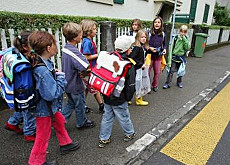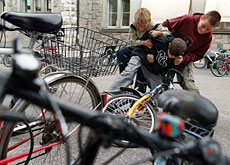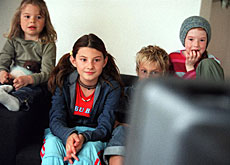School bags are a pain in the back

Heavy school bags are becoming a major health concern of Swiss parents. Pupils in Geneva have threatened to demonstrate over the issue.
Children regularly carry overweight bags, despite campaigns warning teachers and students of the damage that can be done when the load exceeds 15 per cent of a pupil’s body weight.
You see them at almost every bus stop in Switzerland on their way to and from school – heroic pupils battling with huge overloaded rucksacks.
“We often have information from parents that this is a problem,” Thomas Steffen, a school doctor from canton Basel City, told swissinfo.
“Parents should choose a good ergonomically designed school bag and it’s important that a child learns early on that it’s necessary to look after their back,” he added.
Swiss schoolchildren load themselves up like packhorses for many reasons, explained Steffen.
“In Swiss-German regions many schools have no cupboards for children to store their books so they have to carry them home. And many teachers say that today’s books are a lot heavier.”
Steffen said it is important that parents and teachers took more interest in what children take to school.
Weighty words
“A teacher once told me that a little boy in his class used to bring in three dictionaries every day as he had the fixed idea that this was important,” he said.
Dominique Högger, an advisor on school health matters in canton Aargau, agreed.
“When teachers give homework they shouldn’t only be concerned about the work children have to do, but also the amount of materials they have to carry home,” he said.
But the fault is partly that of the students, said Cilette Cretton, pedagogical director for primary and secondary education in canton Vaud.
“Pupils should stop transporting all their books and files out of fear that they’ve forgotten something. And then you’ve got all the other things they stuff into their bags which has nothing to do with school,” she added.
Aches and pains
According to a study in Zurich, one out of 100 children aged ten to 11 complains of back pains. But this increases significantly as they get older.
A similar study this year in canton Basel City found 24 per cent of students aged 14 to 15 suffer from back problems attributable to overloaded school bags.
“Back pains and related problems typically begin during puberty, while younger children are able to compensate,” explained Steffen.
And they can continue into adult life. The Federal Coordination Commission for Occupational Safety warned on Thursday that one in five Swiss workers suffered from back problems which cost the Swiss economy an estimate SFr3 billion ($2.5 billion) a year.
Sit properly!
But back problems among young people are not only caused by weighty school satchels.
Children have a very sedentary life, said the Basel doctor. “We see in new studies that children who move a lot in their daily lives clearly have fewer problems,” he claimed.
But school children should also learn how to sit properly so they don’t damage their backs, said Steffen. “My vision is that in schools we should have similar workplaces to modern offices with flexible chairs and so on; we are moving in that direction,” he added.
swissinfo, Simon Bradley
The spine comprises 24 bone blocks called vertebrae, stacked on top of each other, resting on the pelvis and topped by the skull.
Between each vertebra are spongy but tough cushions called discs, which act as shock absorbers and give the spine its flexibility.
Some of the most common causes of stress and strain on the spine include: slouching in chairs; driving in hunched positions; standing badly; lifting incorrectly; sleeping on sagging mattresses; being unfit and generally overdoing it.
In industrialised countries, up to 80% of the population will experience back pain at some stage in their life. During any one year, up to half of adult population (15%-49%) will have back pain.
The number of people with back pain increases with advancing age, starting in children of school age and peaking in adults aged 35 to 55. Back pain is just as common in adolescents as in adults.

In compliance with the JTI standards
More: SWI swissinfo.ch certified by the Journalism Trust Initiative




You can find an overview of ongoing debates with our journalists here. Please join us!
If you want to start a conversation about a topic raised in this article or want to report factual errors, email us at english@swissinfo.ch.